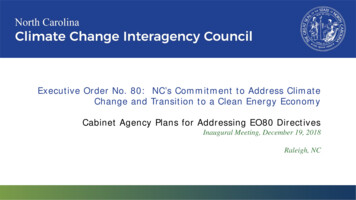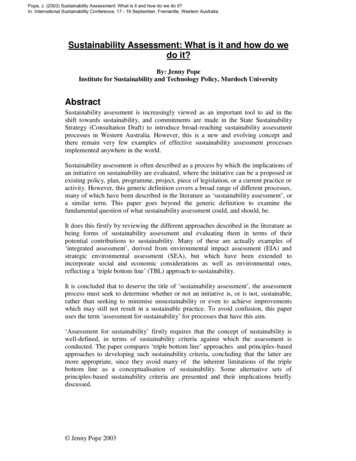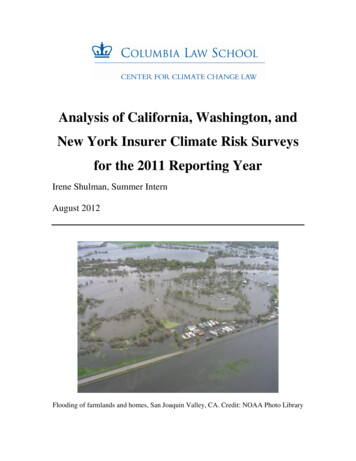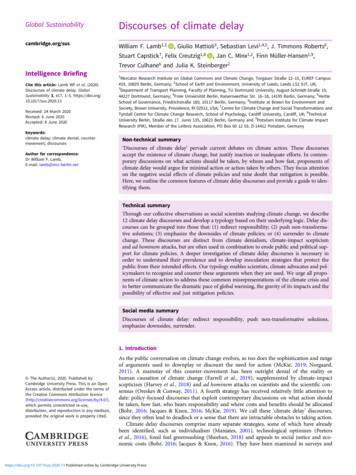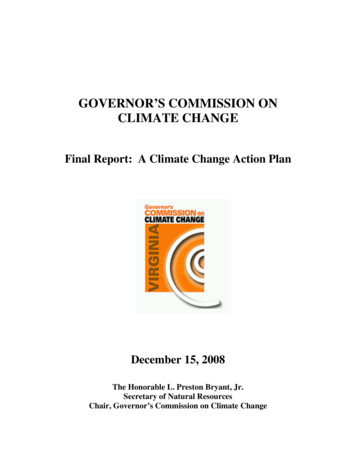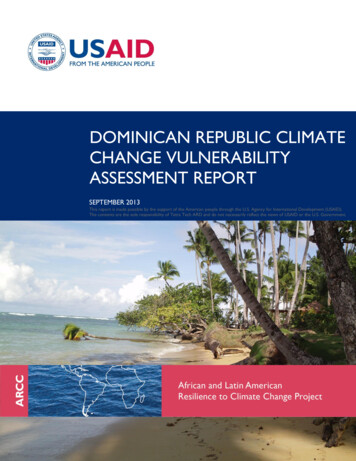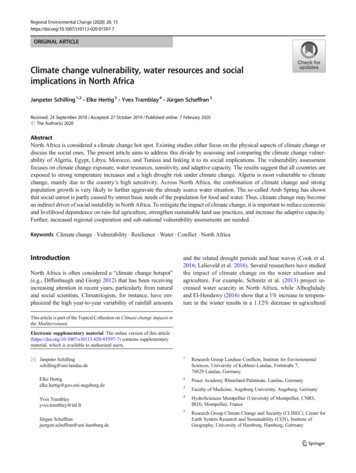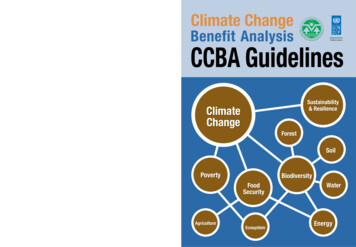
Transcription
icyandPlanningicyandPlanningสำนกั งานนโยบสำนกั งานนโยบ.aturNaEmpowered lives.Resilient nations.United Nations Development Programme12th Floor, United Nations Building,Rajdamnern Nok Avenue, Bangkok 10200www.th.undp.orgวดลอ มสง่ิ และaturNallResoPotalurces and Environmen.ผนทรพั �ยแofOffice.Office of Natural Resources and Environmental Policyand Planning (ONEP)60/1 Soi Phibun Wattana 7, Rama VI Rd.,Phayathai, Bangkok 10400www.onep.go.thClimate Change Benefit Analysis CCBA Guidelinesวดลอ มสง่ิ และofOfficeผนทรพั �ยแllResoPotalurces and EnvironmenEmpowered lives.Resilient nations.Sustainability& tyFor more information:Mr. Pawin TalerngsriProject ManagerInclusive Green Growth and Sustainable Development UnitUNDP ThailandEmail: versityWaterEnergy
Photo Credit: Royal Irrigation Department,Energy Policy and Planning Office, Shutterstock,Sittidaj Pongkijvorasin, and Khemwalai TheerasuwanajakDesign: Khemwalai TheerasuwanajakLayout: Siriporn PornsiritivedPrinting: ANT Office Express Co.,Ltd.Supported byสำนกั งานนโยบวดลอ มสง่ิ และofOfficeicyandPlanningผนทรพั �ยแ.aturNallResoPotalurces and Environmen.Empowered lives.Resilient nations. UNDP 2015All rights reserved
December 2015
ACKNOWLEDGEMENTSThe guidelines were prepared by Christopher Jeth Nicholson, with an overall coordinationby Pawin Talerngsri, and guidance provided by Kevork Baboyan, Glenn Hodes, SutharinKoonphol, Prasert Sirinapaporn, Pathratipa Sansayavichai, and Cholachit Vorawangso.Technical comments were received from following Thai government agencies, researchinstitutes, and experts: Office of Natural Resources and Environmental Policy andPlanning, Office of National Economic and Social Development Board, Bureau of theBudget, Office of Agricultural Economics, Department of Agriculture, Energy Policyand Planning Office, Department of Alternative Energy Development and Efficiency,Office of Transport and Traffic Policy and Planning, Fiscal Policy Office, Royal IrrigationDepartment, Land Development Department, Office of the Permanent Secretary of theMinistry of Natural Resources and Environment, Office of the Permanent Secretaryof the Ministry of Agriculture and Cooperatives, Office of the Permanent Secretaryof the Ministry of Energy, Office of the Permanent Secretary of the Ministry of PublicHealth, Thailand Greenhouse Gas Management Organization, Thailand DevelopmentResearch Institute, Fiscal Policy Research Institute Foundation, ChulalongkornUniversity, Environmental Research and Training Centre, Kitti Limskul, Adis Israngkura,Chayan Tantivasdakarn, and Chanathip Pharino.International peer to peer reviews were provided by Babatunde Abidoye (IndependentConsultant), Chanakod Chasidpon (Office of National Economic and Social DevelopmentBoard, Thailand), Julien Chevillard (UNDP), Kakada Dourng (Independent Consultant),Andreas Karlsen (UNDP), Daniel Klasander (Embassy of Sweden, Thailand), SusanneOlbrisch (UNDP), Sujala Pant (UNDP), Suren Poghosyan (UNDP), Sudip Ranjan Basu(UNESCAP), Hala Razian (UNESCAP), Paul Steele (International Institute for Environmentand Development), Bjoern Surborg (GIZ), Mark Tadross (UNDP), Annabelle Trinidad(UNDP), Madhukar Upadhya (Independent Consultant), and Katinka Weinberger(UNESCAP)The development of these guidelines was part of the Project “Strengthening Thailand’sCapacity to Link Climate Policy and Public Finance”, financially supported by SwedishInternational Development Cooperation Agency (SIDA) and United Nations DevelopmentProgramme (UNDP).”The views expressed in this publication are those of the author and do not necessarilyrepresent the views of UNDP or the government of Thailand.
Contents1. Introduction . 111.1 Purpose . 121.2 Overview . 121.3 Who Should Use these Guidelines . 141.4 When to Use the Guidelines . 141.5 Interaction with Other Guidelines . 172. General Principles . 21Step 1: Climate Change Scenarios . 23Step 2: Physical and Behavioural Parameters . 24Step 3: Implications of Project and CC on Parameters . 25Step 4: Prices and Valuation of Costs and Benefits . 27Step 5: The Cost and Benefit Stream . 30Step 6: The Climate Change Relevance Score (CC%) . 31Step 7: Sensitivity Analysis and Scenarios . 353. Technical Options . 373.1 Overview of the Steps . 383.2 Screening . 393.3 Choosing the Technique . 423.4 Conducting the CCBA . 443.5 Monitoring and Evaluation . 514. Institutions and Operation . 554.1 Institutions . 564.2 Operation . 58Bibliography . 59Annex . 60Annex 1: Example CCBA using Quantitative CBA - Flood Proofing . 61Annex 2: Example CCBA using CBA with Expert Opinion - Biogas Scheme . 64Annex 3: Example CCBA using Participatory Approaches - Conservation Agriculture .66Annex 4: Example CCBA using Expert Opinion and OBA . 68
TablesTable 1: Example Adaptation and Mitigation Projects and Level of Climate ChangeBenefits . 16Table 2: Complementarity of CCBA Guidelines and BoB and NESDB Guidelines . 18Table 3: Example of With and Without Grid for Climate Change and Project . 26Table 4: Likely Ranges for Climate Change Benefits Compared with Other Benefits . 33Table 5: Screening Reference Table . 39Table 6: Typical Guidance for Objectives Based Assessment of Climate Relevance . 50Table 7: Typical Indicators for Monitoring Outputs Leading to Impact . 52Table 8: Operation of the CCBA Guidelines under Existing Planning and Budgeting . 58FiguresFigure 1: The Role of CCBA in Planning and Budgeting . 13Figure 2: Interaction between CCBA and other Guidelines . 19Figure 3: Example Net Benefit Streams and CC% Estimate . 32Figure 4: Screening and Selecting the Appropriate Evidence and Analysis . 38Figure 5: Institutional Arrangement and Responsibilities . 57BoxesBox 1: Climate Change, Sustainable Development, and Green Development . 15Box 2: Accommodating Poverty and Gender in CCBA . 28Box 3: The Carbon Market and the Social Cost of Carbon . 29Box 4: Time Period and Discount Rates . 30Box 5: Cost Effectiveness and Cost Benefit Analysis . 43Box 6: Good Practice in Participatory CCBA . 49Box 7: Template for CCBA Reporting in Budget Submissions . 57
AbbreviationsBCRBenefit Cost RatioBoBBureau of the BudgetCBACost Benefit AnalysisCCClimate ChangeCCBAClimate Change Benefit AnalysisCCFFClimate Change Financing FrameworkCOPConference of the Parties (of UNFCCC)CPEIRClimate Public Expenditure and Institutional ReviewGHGGreenhouse GasIAImpact AssessmentIPCCIntergovernmental Panel on Climate ChangeNDPNational Development PlanM&EMonitoring and EvaluationMOACMinistry of Agriculture and CooperativesMOENMinistry of EnergyNESDBNational Economic and Social Development BoardNPVNet Present ValueOBAObjectives Based AssessmentONEPOffice of Natural Resources and Environmental Policy and PlanningRGTRoyal Government of ThailandSDSustainable DevelopmentSNCSecond National Communication (to UNFCCC)tCO2etons of Carbon Dioxide equivalentUNFCCCUnited Nations Framework Convention on Climate Change
GlossaryAdaptation: Responding to climate change to reduce the loss and damageAppraisal: Ex-ante evaluationDownscaled: Climate change projections that apply to relatively small areas, below thelevel of detail provided in global or regional climate modelsHeadline Scenario: The climate change scenario that is used for the main conclusionsand may then be subject to sensitivity analysisMainstreaming: The process of integrating climate change into the routine processes ofplanning and budgetingMaladaptation: A project that becomes less effective when climate change takes placeMitigation: Reducing greenhouse gas emissions and so reducing climate changeProofing: Changing a project to protect its performance from climate change(CC) Relevance: The extent to which project performance is affected by climate changeScenario: A package of assumptions that produces a particular CCBA resultSensitivity Analysis: Analysis of how the CCBA results change as an assumption changes
PREFACEThailand is one of the countries in Southeast Asia which have explored options forintegrating climate change into national planning and budgeting. It was also one ofthe first group of five countries to produce a Climate Change Public Expenditure andInstitutional Review and has played a leading role in piloting analysis of how climatechange affects the benefits from public expenditure.These guidelines are an important step in moving towards changes in the proceduresused for planning and budgeting and so embedding climate change within themanagement routines for public policy and expenditure. Initially, they will be used ina pilot form, with selected ministries. A more formal version, supported by regulations,will then be introduced.The biggest challenge facing the integration of climate change into planning andbudgeting is the need to build awareness and capacity. This starts with the need tounderstand how climate change will affect the Thai people, especially (but notexclusively) in the key sectors of agriculture, forestry, water, energy, infrastructureand health. Building this understanding of climate change is not easy and will takefive to ten years.At the same time as building understanding about climate change, the governmentwill also build capacity in redesigning services and investments to help protect peoplefrom climate change and to reduce greenhouse gas emissions. Building this capacityis a major task, but it is less complicated than it might seem, once the basicunderstanding of climate change is in place. These guidelines describe methodsto integrate climate change into project design which range from demanding costbenefit analysis, suitable only for large investments, to rapid assessment based onexpert opinion that can be done in a few hours, if there is already an understandingof climate change.The line ministries play the leading role in redesigning projects to take climate changeinto account. The Bureau of the Budget also plays a key role, enforcing any regulationsthat are introduced to require climate change to be taken into account in plans andbudgets. The Office of Natural Resources and Environmental Policy and Planningprovides the technical leadership and supports line ministries by promotingunderstanding about climate change and about how to use these guidelines. Weencourage all line ministries to pursue an active programme of capacity building indealing with climate change and to use these guidelines in preparing budgets, evenbefore any regulations are introduced.
9
10
INTRODUCTION11
1. INTRODUCTION1.1 PURPOSEThe purpose of Climate Change Benefit Analysis (CCBA) is to allow the RoyalGovernment of Thailand (RGT) to identify those investments that will become significantlymore important as climate change takes place, because they reduce the loss anddamage from climate change and/or reduce greenhouse gas emissions. CCBA thenaims to ensure that these investments are properly designed to respond to climatechange and receive appropriate additional funding, either from the budget or fromnational or international climate funds.1.2 OVERVIEWCCBA is the key task for integrating climate change into planning and budgeting, asillustrated in the diagram below. CCBA is used primarily to support budget submissions.It also provides the evidence for objective scoring of public expenditure, so that trendsin climate expenditure can be monitored, and shows how expenditure reduces lossand damage from climate change. These guidelines describe a range of methodsfor estimating benefits, including some default values and a rapid approach that canbe done easily, once there is a clear understanding of how climate change will affecteach project.12
Figure 1: The Role of CCBA in Planning and BudgetingEvaluationsLower CC ImpactOutput MonitoringCC related benefitsCC Annual ReportMid and LongTerm PlansBudget CircularCC ReferencesProgramme RevisionDesign and AppraisalScreening and CCBATagging & ScoringCC relevance CC%Budget SubmissionsRefer to CC ImpactAccountsCC WeightedAccountsBudget NegotiationsRecognition ofCC benefitsImplementationDedicatedClimate FundsNote: climate change influence on activities in greyCCBA is a new feature in the existing process for justifying budget requests. Itshould be used alongside the other techniques required for impact assessment,such as Environmental Impact Analysis (EIA) and Cost Benefit Analysis (CBA). Theseguidelines describe how CCBA can be undertaken with varying levels of detail, tominimise the burden on government officials. For all but the largest and most sensitiveprojects, it is sufficient to undertake a form of rapid CCBA that relies heavily onexpert opinion, using whatever objective evidence is easily available. The major steprequired from officials is to understand how climate change affects their projects andthe structuring of the benefit analysis does not need to be a major burden.The CCBA guidelines were developed through a process of consultation with theOffice of Natural Resources and Environmental Policy and Planning (ONEP), theBureau of the Budget (BoB), the National Economic and Social Development Board(NESDB) and key line ministries. It builds on experience with the Climate PublicExpenditure and Institutional Review and pilot work in the Ministry of Agriculture andCooperatives (MOAC) and the Ministry of Energy (MOEN).13
1.3 WHO SHOULD USE THESE GUIDELINESIt is the responsibility of line ministries in the RGT to use these guidelines to determinewhether CCBA is required and to conduct CCBA in a structured and rigorous manner,with a level of detail that is appropriate for the scale and nature of the proposedexpenditure. Section 4 provides further details of institutional responsibilities formanaging CCBA.1.4 WHEN TO USE THE GUIDELINESChapter 3 describes a screening process to determine which projects need toundertake CCBA and what level of detail is required. The guidelines are to be usedmainly for projects whose benefits are positively affected by climate change. Theyshould be used for public investments including those undertaken by State OwnedEnterprises (SOEs), and also for public policies that affect private investments, suchas regulations and incentives. CCBA is not obligatory for private investments, butcompanies may find it useful as it helps them protect their profitability from climatechange threats.CCBA is required for all projects costing more than THB 50m that are affected byclimate change (see section 3.2). If the project costs more than THB 1,000m, then afull analysis is required. For projects between THB 50m and 1,000m, these Guidelines describe a range of practical options for CCBA that can be completed easilyand rapidly, once the basic impact of climate change on the project is clear. Somesmaller projects of less than THB 50m may also opt to undertake CCBA in order tostrengthen the justification for funding.The benefits may come from adaptation (i.e. reducing the loss and damage arisingfrom climate change) or from mitigation (i.e. reducing greenhouse gas (GHG) emissionsto contribute to the global efforts to stop climate change itself).The guidelines apply to projects that are justified primarily by climate change benefits(i.e. adaptation and mitigation) as well as to projects that are justified primarily bysustainable development (SD) benefits (i.e. economic growth, social development andenvironment), but which has secondary climate change benefits. There are a varietyof different interpretations of the relationship between climate change, sustainabledevelopment and green development, as discussed in Box 1.14
Box 1: Climate Change, Sustainable Development, and Green DevelopmentThe term sustainable development came to prominence after the Earth Summitin Rio in 1992 and was then defined as having three pillars: economic growth,social development and environmental development. Since 1992, climatechange has become steadily more important and, in order to provide addedemphasis on the importance of climate change, the term ‘green development’,or ‘green growth’ has become popular. There are various definitions of greendevelopment, but they generally refer to five dimensions, including the threedimensions conventionally associated with sustainable development and thetwo new dimensions of climate change. Some analyses now use the termsustainable development interchangeably with green development. The CCBAguidelines use the old definition of sustainable development (i.e. coveringeconomic growth, social development and environment) and assume that greendevelopment covers all these dimensions plus the two additional benefits ofclimate change (i.e. adaptation and mitigation).Examples of different combinations of climate change and sustainable developmentbenefits are shown in the table below. CCBA provides options for estimating thevarious benefits.15
Table 1: Example Adaptation and Mitigation Projects and Level of Climate ChangeBenefitsTypeAdaptation ProjectsMitigation ProjectsHigh CCbenefits Vulnerability analysis Community resilience planning Protection for floods & sea levelrise Drought resilient crop varieties Flood proofing roads, irrigationetc. Research on cost effectivenessof reducing GHG emissions Studies on loss and damagefrom not mitigating GHGemissions Public awareness of GHGemissionsMixed CCand SDbenefits Biodiversity corridors Irrigation schemes Community forestry Untargeted water/sanitation Forward plans to tackle CCdiseases Urban plans to reducevulnerability Renewable energy Reforestation Energy efficiency Public transportNegativeCC benefits1 Unsustainable groundwater use Promoting water intensive crops Roads that increase deforestation Fossil fuel subsidiesNegative CC benefits occur if CC reduces the performance of projects, either because of higher lossand damage or because of high GHG emissions. Such projects should normally be generating high SDbenefits, since they would otherwise not be considered for funding.Source: Experience from CPEIR and CCFF work in Southeast and South Asia1CCBA can also be used for projects whose benefits are negatively affected by climatechange. Line ministries (or independent bodies) might be interested to understandthe scale of the climate change risks, compared with sustainable development benefits.And, if the risks related to climate change are widely debated, they might wish touse CCBA to provide more objectivity on the scale of the risks in debate, whether ingovernment policy circles or in public.16
1.5 INTERACTION WITH OTHER GUIDELINESCCBA supplements existing guidance on how to appraise public investment, assummarised in Table 2.The BoB ‘Practical Guide to the Budget’. The annual BoB budget guide requiresbudget submissions to describe, among others:a) the links to national and ministerial strategies and targets;b) the goals and expected results of the expenditure and the impact onbeneficiaries;c) the readiness and efficiency of the agencies delivering the expenditure;d) the challenges faced and conditions for addressing these challenges; ande) the resources requiredThe NESDB Project Appraisal Guidelines 2012. The Guidelines set criteria forappraising an investment project, including:a) the project’s consistency with the national development plan;b) the needs for a project;c) the project’s appropriateness in terms of physical, financial, economicdimensions;d) the project’s impacts on environment; ande) the appropriateness of project management and risk management17
Table 2: Complementarity of CCBA Guidelines and BoB and NESDB Guidelines18BoB GUIDELINESCCBA COMPLEMENTARITYLinks to national and ministerialstrategies (a)Consistency with CC Master Plan and thecontribution to protecting growth and equity inthe NDPImplementation and results (b & d)CCBA identifies possible risks to implementationStrategic goal (b)CCBA requires clear definition of CC relatedbenefitsContribution to ministry targets (b)CCBA requires CC benefits to be estimatedResults and impact onbeneficiaries (b)CC benefits relate to impact on beneficiaries andencourage project design to improve benefitsReadiness and efficiency ofagencies (c)CCBA incorporates cost effectiveness, either onits own or as part of cost benefit analysisChallenges, measures to respond (d)CCBA highlights challenges associated with CCResources required (e)CCBA requires specification of costsNESDB GUIDELINESCCBA COMPLEMENTARITYConsistency with NDP (a)Consistency with CC Master Plan and the contribution to protecting growth and equity in theNDPNeeds of the project (b)CCBA requires estimates of any additional needsarising because of CCAppropriateness (i.e. physical,financial, economic dimensions)(c)CCBA requires evidence-based assessmentof the implications of CC for these dimensions,including on economic performanceEnvironmental impacts (d)CCBA requires evidence-based assessment ofhow CC alters the impact on environmentAppropriateness of projectmanagement & risk management (e)CCBA requires project management to takeexplicit measures to deal with CC risks
Rules regarding the appraisal of large public-private-partnership (PPP) projects ofmore than THB 1,000 million are defined by the B.C.2556 PPP Act which specifiesthat, for public-private-partnership (PPP) projects, NESDB provides recommendationson appraisal, but project appraisal is done by the State Enterprise Policy Office, whois also responsible for submitting the project to Cabinet. For a project of more thanTHB 1,000 million that is not a PPP project, Cabinet approval is also required. TheSecretariat of the Cabinet decides whether the project should be sent to NESDB forfull appraisal and recommendations or whether to submit directly to Cabinet.Figure 2 shows the budget submission and approval process and how the CCBAsupplements other guidelines.Figure 2: Interaction between CCBA and other GuidelinesLine ministries select services/projects for the budgetBoB PracticalGuide to the BudgetYCCBA Screening andTechnique SelectionInvestment greater than THB 1,000 millionas per PPP Act and existing NESDB guidelinesFull Cost Benefit AnalysisNESDB ProjectAppraisal GuidelinesNResults Analysis with Mixed EvidenceCCBA BenefitAnalysis OptionsBoB PracticalGuide to the BudgetBoB Budget Approval19
20
GENERAL PRINCIPLES21
2. GENERAL PRINCIPLESThe general principle behind all CCBA is to assess the relative importance of adaptationand mitigation benefits, compared with other sustainable development (SD) benefits(i.e. economic growth, social development and environment). This comparison givesan indication of the extent to which climate change should increase the prioritizationgiven to the project.CCBA draws on the basic concepts of Cost Benefit Analysis (CBA) and ImpactAssessment (IA). It requires an assessment of how benefits change over the periodto 2050, which is a typical date used for climate change projections. CCBA can bedone using classic CBA/IA methods, using as much hard evidence as possible, orthey can be applied in a less detailed way, with varying sources of more qualitativeassessment. There are many guides on conducting CBA and IA and these CCBAguidelines do not aim to duplicate these (Chutubtim 2001; World Bank 2009; WorldBank IEG 2010; HMG 2011; UNFCCC 2011; ADB 2013). The following guidanceshows how the specific requirements of CCBA influence the way in which CBA/IA isdone.The main steps in CCBA are as follows:1. Select the CC scenarios to be used (e.g. IPCC, downscaled, trend-basedscenarios);2. Define how the parameters, both physical (e.g. yields) and behavioural(e.g. enterprises), and how the inputs (i.e. project expenditure) lead to theoutputs (e.g. changes in yields, water flows, electricity, disease cases, etc.);3. Define how the project changes these parameters, both with CC andwithout CC;4. Estimate prices for all costs and benefits;5. Estimate the total value of costs and benefits, with and without CC;6. Estimate the CC relevance (CC%), defined as CC benefits as a proportionof total benefits; and7. Conduct sensitivity analysisFor a single ex-anti appraisal, these steps will normally be taken sequentially. It isoften good practice to proceed rapidly through the steps to obtain an initial resultand then return to refine the analysis. The structure of the CCBA should provide thebasis for monitoring and evaluation.22
Step 1:ClimateChangeScenariosStep 2: Physicaland BehaviouralParametersStep 3:Implications ofProject and CC onParametersStep 4: Pricesand Valuationof Costsand BenefitsStep 5:The Cost andBenefit StreamStep 6: TheClimate ChangeRelevance Score(CC%)Step 7:SensitivityAnalysis andScenariosStep 1: Climate Change ScenariosCCBA requires CBA/IA to be done with and without climate change, to show howthe performance of the project is affected by climate change. CCBA should not berequired to undertake climate change modelling, but should use existing evidenceand contract specialist studies, for larger investments where detailed results arecritical. The scenarios of climate change should be based on as many sources aspossible, including the followings: The IPCC climate change analysis is the starting point. Ideally, projectionsshould be based on the Fifth Assessment Report (AR5) and should use theRCP2.6 scenario (IPCC 2014) to avoid overstating the case. When referringto AR4 (IPCC 2007), or to the Special Report on Extreme Events (IPCC 2012),the B1 scenario should be used. The IPCC scenarios may be sufficient formore rapid CCBA; Downscaled projections of climate change are now available in Thailand andshould be used for projects that are based in one geographical area. Thesewill be necessary for more detailed CCBA (e.g. as required for large investments).Particular care must be taken in analysing extreme events, which may requiresome integration of hydrological modelling with climate change modelling,for large investments; and Where historical records are available for three decades or more, these shouldbe analysed to assess whether past trends are consistent with future projections.This can usually be done quickly and so can be used in rapid CCBA, as wellas full CCBA.Given the uncertainty about climate change, it is normal to undertake the analysis,using one main scenario (or ‘headline’ scenario) for climate change and then repeatthe analysis with at least one other climate change scenario. The headline scenarioshould normally be an optimistic scenario (i.e. RCP2.6 or B1, as suggested above),with little climate change and low benefits from adaptation and mitigation. Thesensitivity analysis may refer to another scenario to show how adaptation andmitigation may give higher value with more severe scenarios.23
Step 1:Climate ChangeScenariosStep 2:Physical andBehaviouralParametersStep 3:Implications ofProject and CC onParametersStep 4: Pricesand Valuationof Costsand BenefitsStep 5:The Cost andBenefit StreamStep 6: TheClimate ChangeRelevance Score(CC%)Step 7:SensitivityAnalysis andScenariosStep 2: Physical and Behavioural ParametersAny
CCBA Guidelines For more information: Mr. Pawin Talerngsri Project Manager Inclusive Green Growth and Sustainable Development Unit UNDP Thailand Email: pawin.talerngsri@undp.org Climate Change Sustainability & Resilience Poverty Agriculture Food Security Biodiversity Forest Water Energy Soil Ecosystem United Nations Development Programme

